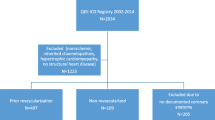Abstract
The Global Use of Strategies to Open Occluded Coronary Arteries (GUSTO)-3 atrial fibrillation (AF) substudy assessed the prognostic significance of AF during acute myocardial infarction (AMI), the use of antiarrhythmic therapies, and whether different antiarrhythmic therapies were associated with different outcomes.
The timing of the onset of AF relative to other post-AMI complications was recorded in the study. Of the 13,858 patients who were in sinus rhythm at the time of enrolment into GUSTO-3, 906 (6.5%) developed AF and 12,952 did not. Worsening heart failure, hypotension, third-degree heart block, and ventricular fibrillation were independent predictors of new-onset AF. The risks of 30-day and 1-year mortality were increased among patients with AF versus patients without AF before (odds ratio [OR] 2.74, 95% confidence interval [CI] 2.56–3.34; and OR 2.93, 95% CI 2.48–3.46, respectively) and after adjustment for baseline factors and pre-AF complications (OR 1.49, 95% CI 1.17–1.89; and OR 1.64, 95% CI 1.35–2.01, respectively).
A total of 1,138 patients had data available on the management of their AF, including 117 with a history of paroxysmal AF and 138 with chronic AF prior to AMI. Of these 1,138 patients, 317 (28%) received antiarrhythmic therapies: class I antiarrhythmic drugs in 12%, sotalol in 5% and amiodarone in 15%. Electrical cardioversion was attempted in 116 patients (10%). Sinus rhythm was restored in 72% of patients given class I drugs, 67% of those given sotalol, 79% of those given amiodarone, and 64% of those who underwent electrical cardioversion. After adjustment for baseline characteristics and pre-AF complications, none of the specific antiarrhythmic therapies was associated with a higher chance of having sinus rhythm at discharge or before deterioration to in-hospital death. However, the use of class I antiarrhythmic drugs or sotalol was associated with lower unadjusted 30-day and 1-year mortality rates. After adjustment for baseline factors and pre-AF complications, the ORs for 30-day and 1-year mortality were 0.42 (95% CI 0.19–0.89) and 0.58 (95% CI 0.33–1.04), respectively, with class I agents, and 0.31 (95% CI 0.07–1.32) and 0.31 (95% CI 0.09–1.02), respectively, with sotalol. In contrast, there was no association between the use of amiodarone or electrical cardioversion and 30-day or 1-year mortality.
New AF is often secondary to other post-AMI complications, but is in itself an independent predictor of a worse outcome. Clinical management of AF is variable, but in GUSTO-3 there was a strong trend towards lower mortality associated with the use of class I antiarrhythmic agents or sotalol. Randomized trials are needed to investigate this observation further.
Similar content being viewed by others
References
Luria MH, Knoke JD, Wachs JS, Luria MA. Survival after recovery from acute myocardial infarction: Two and five year prognostic indices. Am J Med 1979;67:7-14.
Cristal N, Szwarcberg J, Gueron M. Supraventricular arrhythmias in acute myocardial infarction: Prognostic importance of clinical setting; mechanism of production. Ann Intern Med 1975;82:35-39.
Helmers C, Lundman T, Mogenson I, Orinius E, Sjogren A, Wester PO. Atrial fibrillation in acute myocardial infarction. Acta Med Scand 1973;193:39-44.
Behar S, Zahavi Z, Goldbourt U, Reicher-Reiss H, and the SPRINT Study Group. Long term prognosis of patients with paroxysmal atrial fibrillation complicating acute myocardial infarction. Eur Heart J 1992;13:45-50.
Eldar M, Canetti M, Rotstein Z, Boyko V, Gottlieb S, Kaplinsky E, Behar S, for the SPRINT and Thrombolytic Survey Groups. Significance of paroxysmal atrial fibrillation complicating acute myocardial infarction in the thrombolytic era. Circulation 1998;97:965-970.
Pedersen OD, Bagger H, Kober L, Torp-Pedersen C, on behalf of the TRACE Study Group. The occurrence and prognostic significance of atrial fibrillation/-flutter following acute myocardial infarction. Eur Heart J 1999;20:748-754.
Rathore SS, Berger AK, Weinfurt KP, Schulman KA, Oetgen WJ, Gersh BJ, Solomon AJ. Acute myocardial infarction complicated by atrial fibrillation in the elderly: Prevalences and outcomes. Circulation 2000;101:969-974.
Crenshaw BS, Ward SR, Granger CB, Stebbins AL, Topol EJ, Califf RM, for the GUSTO-I trial investigators. Atrial fibrillation in the setting of acute myocardial infarction: The GUSTO-I experience. JAmColl Cardiol 1997;30:406-413.
Wong CK, White HD, Wilcox RG, Criger DA, Topol EJ, Califf RM, Ohman EM. New atrial fibrillation after acute myocardial infarction independently predicts death: The GUSTO-3 experience. Am Heart J 2000;140:878-885.
Wong CK, White HD, Wilcox RG, Criger DA, Topol EJ, Califf RM, Ohman EM. Management and outcome of patients with atrial fibrillation during acute myocardial infarction: The GUSTO-3 experience. Heart 2002;88:357-362.
The GUSTO-III Investigators. A comparison of reteplase with alteplase for acute myocardial infarction. N Engl J Med 1997;337:1118-1123.
Author information
Authors and Affiliations
Rights and permissions
About this article
Cite this article
Wong, CK., White, H.D., Wilcox, R.G. et al. Significance of Atrial Fibrillation During Acute Myocardial Infarction, and its Current Management: Insights from the GUSTO-3 Trial. Card Electrophysiol Rev 7, 201–207 (2003). https://doi.org/10.1023/B:CEPR.0000012382.81986.47
Issue Date:
DOI: https://doi.org/10.1023/B:CEPR.0000012382.81986.47




